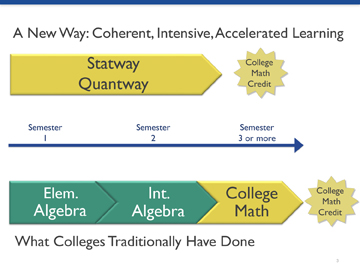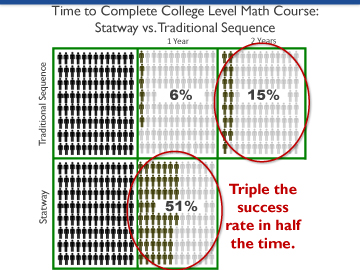
Volume XXXVI, No. 24 | October 24, 2014
Reclaiming Mathematical Lives and Ensuring Rigor
Developmental mathematics is a burial ground for student aspirations; it is the first attempt for many students to gain entry into education beyond high school and, in many cases, the last chance they have to realize their dreams of earning a college degree. Between 60 and 70 percent of students placed into developmental mathematics do not successfully complete the sequence of required courses, and as many as 80 percent of those students do not complete a college-level course within three years. Many students spend long periods of time repeating courses, and most of them simply leave school, either feeling that they are not capable of learning mathematics or that they can’t face what seems like a lengthy and difficult road ahead. As a consequence, millions of students each year are not able to progress toward their career and life goals, even when earning successful grades in their other courses. Equally important, these students lack a command of the math skills that matter for their personal lives in an increasingly quantitative age and to be critically engaged citizens.
A disproportionate number of students who place into developmental math courses are from traditionally underserved populations, from families whose primary language is not English, and typically from families where neither parent has a postsecondary degree. Our educational systems have not served these students well. Yet, they arguably are the students we should care about the most, even as their lack of success remains one of education’s biggest problems.
High failure rates in developmental mathematics have consequences for students and taxpayers. Current estimates from Strong American Schools indicate that remediation costs range from $1.9 to $2.3 billion at community colleges and an additional $500 million at four-year institutions. Add to this sum the costs students shoulder as they enroll semester after semester in courses that do not count toward their degree. The psychological and opportunity costs to students are substantial as well. While they are enrolled in remediation, students expend limited time and financial resources, accumulate debt, and forego earnings from employment. In some states, they deplete their eligibility for financial aid.
Thinking that we have both a moral and an economic imperative to help these students succeed, Carnegie has developed a solution with a unique approach.
The Carnegie Solution: Pathways Approach
Putting the day-to-day work of educators at the center of Carnegie’s effort has been critical to our unparalleled success. In collaboration with faculty, institutional researchers, academic leaders, instructional designers, technologists, and other academic experts, Carnegie formed Networked Improvement Communities to focus on the high-leverage problem in developmental mathematics. Rather than let the traditional student struggle through a required two-year sequence of courses leading to calculus, now students and faculty are joined in a common, intensive pursuit of a shared goal—for students to achieve college math credit in one year through two new mathematics pathways— Statway® and Quantway®.
Statway® is designed as a one academic year course that allows students to simultaneously complete their developmental mathematics requirements and receive college mathematics credit in statistics. Quantway® is designed as two separate semester courses. Quantway 1 fulfills the requirements for students’ developmental mathematics sequence, and Quantway 2, the subsequent semester course, is the college-level quantitative reasoning course.

The Pathways employ a distinct instructional vision using three research-based learning opportunities to promote their ambitious learning goals:
- Productive struggle. As detailed in Hiebert and Grouws (2007), students are more likely to retain what they learn when they expend effort “solving problems that are within reach and grappling with key mathematical ideas that are comprehensible, but not yet well formed” (Schmidt & Bjork, 1992). Consequently each new subject matter topic begins with a rich problem that engages students’ thinking and stimulates this struggle to understand.
- Explicit connections to concepts. Sometimes mathematics is taught with a focus on procedural competence at the expense of advancing real conceptual understanding (Boaler, 1998). Research suggests that making explicit connections among mathematical or statistical facts, ideas, and procedures can improve conceptual and procedural understanding (Hiebert & Grouws, 2007).
- Deliberate practice. Classroom and homework tasks are designed to overcome gaps in understanding, apply what is learned, and deepen students’ facility with key concepts (Ericsson, 2008; Ericsson, Krampe, & Tescher-Römer, 1993). Deliberate practice eschews rote repetition for carefully sequenced problems developed to guide students to deeper understanding of core concepts (Pashler, Rohrer, Cepeda, & Carpenter, 2007).
These three learning opportunities are actualized in the specific lessons, assessments, and out-of-class resources that form the curriculum for each Pathway. Both of the Pathways use face-to-face and online learning with an instructional system that includes:
- Ambitious learning goals leading to deep and long lasting understanding;
- Lessons and out-of-class materials to advance these goals;
- Formative and summative assessments, including end-of-module and common end-of-course assessments;
- Productive persistence—an evidence-based package of practical student activities and faculty actions integrated throughout the instructional system to increase student motivation, tenacity, and skills for success;
- Language and literacy component that interweaves necessary supports in instructional materials and classroom activities so that learning is accessible to all;
- Advancing quality teaching component to provide instructors with the knowledge, skills, and habits necessary to experience efficacy in initial use and develop increasing expertise over time; and
- Analytics to support the continuous improvement of teaching and of the materials.
Apples to Apples
In both of our Pathways, students successfully complete their developmental mathematics requirements and earn college credit at rates two or three times higher than is typical, and do so in roughly half the time. To date, the Pathways have reached 9,000 students in nearly 50 community colleges and universities. These students who had placed into developmental math have had the benefit of higher success rates and greater likelihood of attaining college-level mathematics credit.
After three years of maintaining its success rate, Carnegie recently completed an “apples to apples” comparison study in order to be confident about its results.

The Pathways have retained their high level of performance, despite the inherent strains and variation introduced—increasing the number of college sites, the usual faculty turnover through workload assignments, and introducing new faculty to this community.
To check the veracity of the data, Carnegie used a technique known as propensity score matching. We matched the students at each college using a combination of 44 different criteria, including student background, enrollment history, and prior performance data. We then used this “matching score” to select five students from the pool of students in developmental math at each institution who best matched each of the students in the Pathways.
In the Quantway study, we found that only 37 percent of the matched students successfully completed developmental math with a C or better over two terms. However, Quantway students achieved a 56 percent success rate over one term. Even when Carnegie limits the comparison group to those most like Quantway students—those more likely to be on one or two course levels below than the developmental math population at large—Quantway still outperforms the comparison group by 19 percentage points. And Quantway students are realizing this success rate in a single term.
The findings also held true for the statistics pathway, Statway. Carnegie completed two years of analysis. We again created comparison groups at each college, using 44 different variables to select five developmental math students who best matched each of the Statway students. For the comparison group, we looked at the cumulative completion rate (of a credit-bearing mathematics or statistics course) across two academic years. In both comparison years, Statway was three times as effective in half the time. Furthermore, our findings suggest that the Statway effect persists even after students complete the program: post Statway, students tended to accumulate more college credits with a grade of C or higher than their non-Statway counterparts.
Assured that our results are consistent and reliable, Carnegie’s new aim is to dramatically scale the Pathways. The goal is to increase college and faculty participation and make the Pathways the default math experience for students placed into developmental math, ensuring their most likely chance of success.
Bernadine Chuck Fong, Senior Partner; President Emerita, Foothill College
For further information, contact the author at Carnegie Foundation for the Advancement of Teaching, 51 Vista Lane, Stanford, CA 94305. Email: fong@carnegiefoundation.org


Leave A Comment
You must be logged in to post a comment.